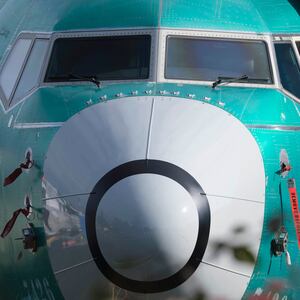Should Boeing and the world’s air safety regulators have moved faster to question the safety of the 737 MAX-8 after the crash of Lion Air Flight 610 last October and grounded the world’s fleets of the new model, as they later did?
Had they done so, that would probably have prevented the second catastrophic crash in Ethiopia that killed 157 people because of striking similarities between the two events.
These acute questions arise after two new reports have switched attention back to that first crash in Indonesia that killed 189 people.
Reuters reported Wednesday that three sources revealed to them snatches of conversation between the Lion Air pilots recorded on the cockpit voice recorder.
It was already known that for a large part of the 11-minute flight following takeoff from Jakarta the pilots were engaged in a losing struggle to regain control of the airplane from a rogue computer-directed action that was forcing down the nose of the airplane. Eventually it entered a terrifying dive into the Java Sea.
According to the Reuters account, the captain asked the copilot to go through the quick reference flight manual for help in identifying what was happening. Reportedly neither realized that their command of the flight was being overridden by the computers.
Boeing subsequently admitted that the manual did not include any reference to the existence of the malfunctioning system, Maneuvering Characteristics Augmentation System, MCAS, nor had the pilots been made aware of it during training to prepare them for switching to the new model 737 from the previous model.
Bloomberg also reports that the same airplane on its previous flight encountered an identical problem and was saved only because there was a third pilot in the cockpit making what is called a “dead-head” trip on a jump seat and that this pilot correctly diagnosed the problem and told the crew how to recover from it.
The pilots basically pulled the plug on the rogue system by reverting to manual control, flipping two switches to cut off the computerized flight management system and giving back to them control of the horizontal stabilizer–the main control surface in the tail that was forcing down the nose.
With the computers disengaged the pilots were able safely to hand-fly the airplane to its destination, Jakarta.
These two accounts now bring renewed focus on what happened to that airplane as it sat in Jakarta overnight before its fatal flight.
Lion Air has said that the pilots reported the incident and that the aircraft’s systems were fully checked and it was cleared to fly.
Not only is that now in question but it puts the airline itself and its maintenance practices at the center of the crash investigation. It is already established that the system forcing down the nose, MCAS, was doing so because it was receiving false readings from a sensor in the nose of the MAX-8–a sensor designed to detect if the airplane is nosing up into an aerodynamic stall.
If the fault in that airplane on that day had been traced to the sensor it could not have left the gate before the sensor was replaced and the new sensor checked. The fact that the flight was allowed to leave the gate will be a key part of the investigation now under way, and the outcome could be very damning for Lion Air.
Experts on flight control systems are debating why Boeing decided not to disclose the presence of a few lines of code buried deep in the airplane’s avionics software.
MCAS was not an update; it was a patch to fix a problem that first showed up in Boeing’s wind tunnel tests to show how the MAX-8 behaved in some of the outer edges of the flight envelope.
A pilot with long experience of developing new systems told The Daily Beast that the specific problem that showed up in the wind tunnel, a risk of an aerodynamic stall during a steep turn, would occur very rarely, if at all, during normal airline operations.
Nonetheless Boeing recognized that it was a risk introduced with the MAX-8 that had not been present in earlier 737 models and that it had to be addressed. What seems not to have been anticipated is that a false reading in a single sensor could trigger the MCAS and have a fatal result.
The possibility of a single-point failure is in itself of great concern–all critical control systems are supposed to have at least one backup system.
The sequence of failures in the Lion Air MAX-8 was identified within a week of the disaster, when it was also disclosed that Boeing had not included MCAS in the flight manual.
The Ethiopian crash suggests that many pilots flying the new model 737 remained unaware of how to deal with a repeat of the Lion Air sequence of events–though the revelation about the third pilot who saved the earlier flight indicates that others did. And so the fate of passengers was left to chance for five months, until another 157 people died.







